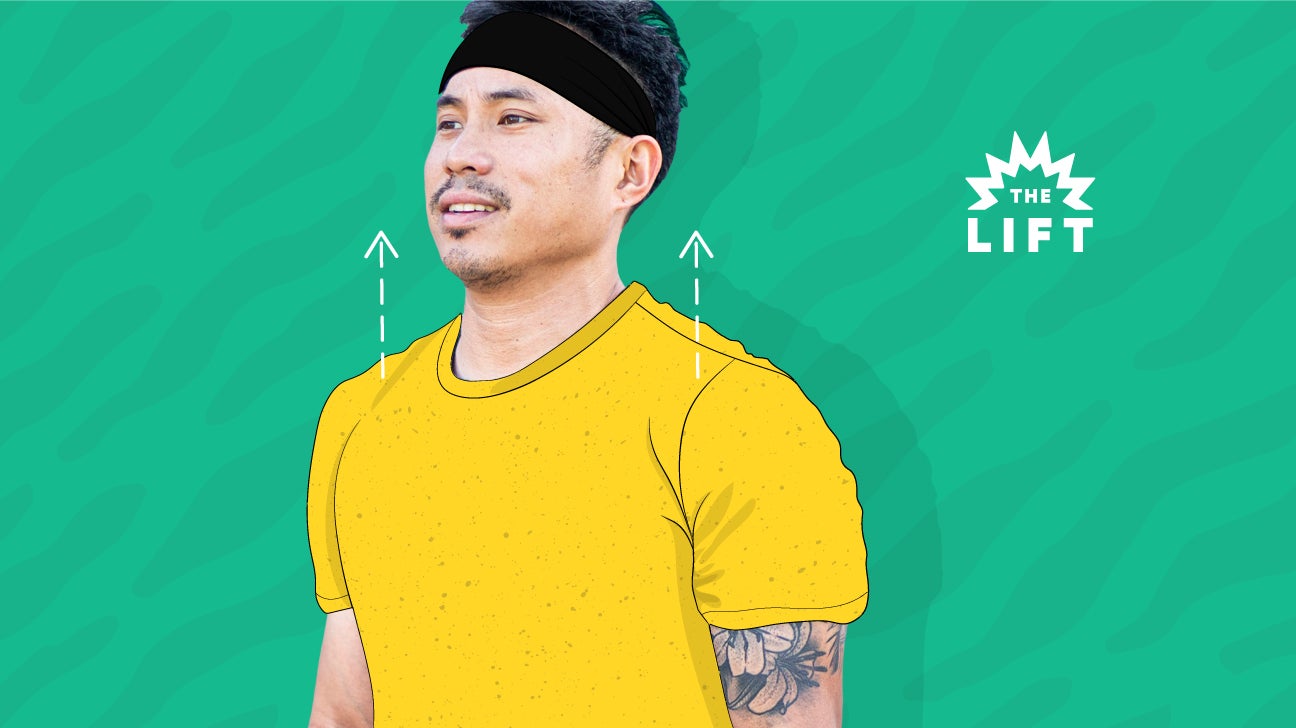This is “The Lift,” where we break down simple fitness activities you can do anywhere — and not just do them, but do them right. With these helpful tips, you can take control of your exercise process at your pace.

In your gadgets the shoulder shrug is just a cutesy emoji (🤷). But in the gym, it’s an upper-body, muscle-molding movement.
The problem is, do it wrong, and you could eff up your neck and shoulders.
Scroll down for the 101 on shoulder shrugs.
Welcome to trap city
As an isolation exercise, shoulder shrugs do to your upper trapezius muscle what bicep curls do to your biceps: bulk ‘em big time.
“The shoulder shrug is one of the few exercises that works just one muscle,” says Alejandro Badia, MD, board-certified hand, wrist, and upper extremity orthopedic surgeon with Badia Hand to Shoulder Center in Florida.
The fact that this move has a singular muscle focus may make you think you could skip it altogether. But actually, that’s not the case. Located at the base of the neck, you probably know your upper traps as the muscle that (ahem) traps stress, making your neck and shoulders feel stiff AF.
The upper trapezius is also the muscle that controls the movements of your scaps and upper back, Badia explains, helping you reach into the top cabinets for the Rose as well as lift a case off the porch.
The upside with having good traps
Strong upper traps are important for building a balanced upper-body, explains Badia. “You risk shoulder pain if your traps are so much weaker than the rest of your upper-body.”
In fact, he goes on to say that physical therapists spend quite a bit of time strengthening the traps in sessions with people who have shoulder pain and impingement.
One small study even found doing shoulder shrugs with dumbbells, alongside other neck strengthening movements, has the potential to relieve neck pain. Impressive.
Don’t just shrug off all of your aches
If you’re experiencing shoulder and neck pain, don’t start shrugging willy-nilly. “Shrugs will absolutely aggravate folks who deal with tension headaches or AC joint pain,” says Marcia Denis, PT, DPT and founder of Just Move Therapy in South Florida.
Working with a physical therapist will help you determine which movements will and will not provide relief.
In addition, there’s always the aesthetic factor.
Of course, there isn’t just one way to look athletic or beautiful. But Badia explains that generally, “if you have atrophied upper traps but strong deltoids, pecs, and shoulders, it’s not going to look very good. Strong upper traps add a look of fullness to the upper body that makes the body look more symmetrical,” he says.
The rub with shrugs
Shoulder shrugs may seem harmless, but according to Badia, there are two big problems people run into with the movement.
Problem #1: Form can flop easily
Let the record show: There’s no “rolling” movement included in the proper shoulder shrug.
“Many people get the technique wrong while doing shoulder shrugs and roll their shoulders rather than shrugging them,” says Badia.
Best case scenario: this takes the emphasis off your traps and puts it on your shoulders. Worst case scenario: this can lead to muscle tearing or nerve impingement. No thanks.
Dr. Marcia’s suggestion? “Take videos to learn your form. Watch them and study when and how form breakdown occurs, if it does. Take note of your body’s cues and how you feel the next couple of days.”
So, if you flubbed your form, your body will let you know.
How to do a shoulder shrug the right way, according to Dr. Marcia
- Take an athletic stance, feet shoulder-width apart. Hinge back to pick up two weights, one in each hand, palms facing your thighs.
- Tuck rib cage under body to engage your middle and squeeze glutes for stability. Then, pull your shoulders back by thinking about squeezing a penny between your lats.
- Keeping your gaze neutral and arms straight, inhale as you shrug straight up, elevating shoulder blades.
- Exhale as you return to start, then repeat.
Problem #2: Ego can take over
It’s totally OK that you can only lift what you can lift in this current moment. So, for the sake of your neck/spine/shoulders don’t let your ego convince you to lift more than that!
“If you put too much weight on the trapezius it can result in tears that cause shoulder and neck pain,” says Badia. “It can also aggravate muscular arthritis in the neck or lead to nerve injury.”
He recommends picking a weight you can comfortably do 12+ reps with. “This isn’t a movement you’re ever going to test your one rep max with.”
Shoulder shrugs shouldn’t be a one-move show
Yes, strong upper traps are important. But “if you only strengthen your upper traps, you will throw your shoulders out of their ideal movement pattern and possibly into pain,” says Marcia.
To actually foster proper shoulder mechanics and build symmetry, she says you also need to be hitting your middle and lower traps. For that, she says, “You need to lay on the ground or a bench and work something like on Is, Ys, & Ts.” (FTR: You can also do that exercise with TRX straps).
Variety, after all, is the spice of life exercise.

0 Commentaires